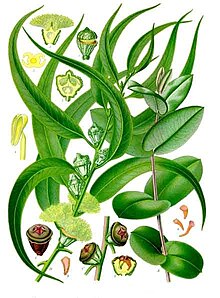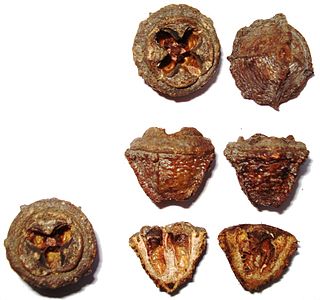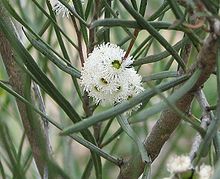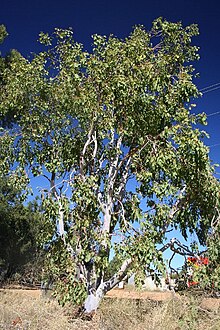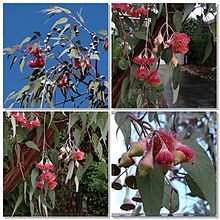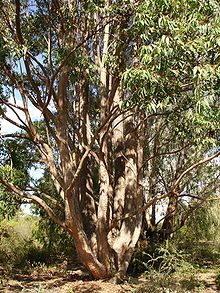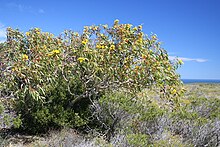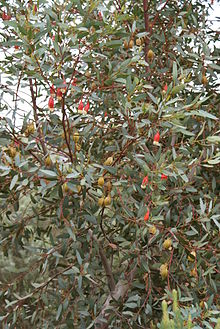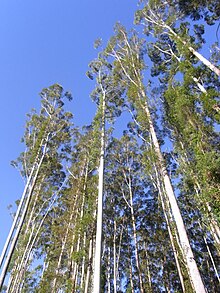Eucalyptus
| Eucalyptus | ||||||||||||
|---|---|---|---|---|---|---|---|---|---|---|---|---|

|
||||||||||||
| Systematics | ||||||||||||
|
||||||||||||
| Scientific name | ||||||||||||
| Eucalyptus | ||||||||||||
| L'Her. |
The eucalyptus ( Eucalyptus ), and blue gum trees called, are a diverse plant genus in the family of the myrtle family (Myrtaceae). The over 600 species are native to Australia and Indonesia .
description
Habitus
Most eucalyptus species are fast-growing, tall, evergreen trees and shrubs ( e.g. Eucalyptus vernicosa from western Tasmania). The giant eucalyptus ( Eucalyptus regnans ) is considered to be the deciduous tree with the greatest growth height; a specimen of this species was measured with a stature height of 97 m and a trunk circumference of up to 20 meters on Tasmania .
Bark and bark
The appearance of the bark of eucalyptus trees changes with age. Like other trees, eucalyptus species add a new layer of bark every year and thus expand their trunk volume. In some species, the outermost layer dies and then comes off the tree in long strips (as in Eucalyptus sheathiana ) or in differently sized "flakes" ( Eucalyptus diversicolor , Eucalyptus cosmophylla or Eucalyptus cladocalyx ). In many species, however, the dead bark can simply remain on the tree. The effects of the weather give this bark its typical, aging appearance. Many other species are also known as half-barks and blackbutts , which alludes to the fact that in these species the dead bark is only kept in the lower part of the trunk or as a large, black cluster directly at the foot of the tree. The smooth, upper and younger bark of the half-barks and the bark of other smooth-barked eucalyptus species can take on remarkable and highly interesting colors (such as Eucalyptus deglupta ).
leaves
The youth leaves and the leaves on older trees differ significantly in most species ( heterophylly ). For example, the youth leaves are opposite - the adult leaves are alternate and the adult leaves are often sickle-shaped or heart-ovoid. Most of the leaves are leathery. The leaf blade is often rotated by 90 ° in order to offer less contact surface for the high radiation.
Inflorescences, flowers and fruits
The umbellate and often compound inflorescences often contain many flowers.
The hermaphroditic, radial symmetry flowers are fourfold. During the bud stage, the flower is surrounded by a capsule called an “operculum”, which usually consists of the less conspicuous (mostly 2 × 4) bracts . Instead of conspicuous bracts, the flowers contain a large number (20 to 150) of long stamens , which can be white, red or yellow in color, depending on the species. Sometimes only part of the stamens is fertile . The flower is not adorned with the bracts, but with the stamens, which occurs in different flowering plant taxa. When the flower opens, the stamens expand and the operculum is blown off. The name of the eucalyptus (Greek: "well hidden") is derived from the operculum and its function. Two to seven carpels are fused into a semi-subordinate or subordinate ovary and a common pistil. Pollination occurs by insects ( entomophilia ) or birds ( ornithophilia ).
The fruit stands often look like a cone. The woody, dry capsule fruits , also called gumnuts in English , are mostly cone-shaped and have valve-like openings at their ends which, when opened, release the actual seeds.
Fruits of Eucalyptus globulus
Seeds of Eucalyptus camaldulensis
distribution
Eucalyptus have their home in Australia , including Tasmania and the eastern half of Indonesia . Today, however, some species also grow in many other subtropical areas of the world. In Australia today, 70% of the trees are eucalyptus. No other continent has a tree population so strongly dominated by a single species. The area of the natural eucalyptus population in Australia is more than 110,000 km² (as of 2009).
In several regions of the world where eucalyptus species are not native, eucalyptus is cultivated because of its rapid growth and good wood quality. Examples of such regions are Southern Europe and South Africa. Eucalyptus species are grown in more than 90 countries on a total area of more than 220,000 km², twice the area of natural eucalyptus forest in Australia.
The area of the eucalyptus plantations corresponds to about twelve percent of the area of all forests and wood plantations and about 0.5 percent of all forest areas worldwide (as of 2009). On about 130,000 km² (that is almost 60 percent of the total eucalyptus plantation area) productivity is high enough to meet the requirements of the wood industry (as of 2009); the rest of the plantation area is rated as "unproductive".
ecology
Fodder plant
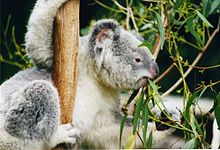
Eucalyptus are the forage plants of the koala and some other marsupials . For most other animal species, however, they are poisonous and useless. Koalas also prefer to eat old leaves, in which the toxins are no longer as concentrated as in the young shoots and leaves.
Effects in the ecosystem
The cultivation of eucalyptus often leads to problems because it dries out the soil deeply, does not provide a habitat for native animals, aggressively displaces other plant species and increases the risk of forest fires . In various regions, the more intense forest fires fueled by eucalyptus have had a negative impact on the local fauna, reduced the nutrient content of the soil and led to greater soil erosion. With programs such as Working for Water , eucalyptus, among other things, are specifically removed in order to primarily eliminate the damage they cause in the water balance of individual regions.
Forest fire hazard
Eucalyptus spec. promotes the likelihood and intensity of forest fires with its highly combustible oils . Some of the eucalyptus species used in forestry in the Mediterranean region also release oily substances into the soil , which further increases the risk of forest fires. The "eucalyptus" also has the property of shedding large branches from time to time. The branches lying on the ground are particularly helpful in forest fires, because they bring the fire closer to the tree.
Eucalyptus species benefit from forest fires because their rhizomes and seeds survive a fire and sprout again very quickly before other plant species have recovered. Compared to other forest plants, fire has a positive overall balance because it not only eliminates parasites, but also helps the eucalyptus to reproduce ( pyrophilia ). The seed shells of the tree can burst, especially due to the high heat of the fire. Many eucalyptus species form so-called lignotubers , which enable them to sprout again even after the above-ground parts of the plant have been completely destroyed.
During the forest fires in Portugal in 2017 , the environmental protection organization Quercus criticized the fact that the authorities had promoted the cultivation of eucalyptus and mainly burned eucalyptus stocks.
use
Wood
Eucalyptus are primarily used to produce wood. Of the approximately 700 species, 37 species are considered for use in the timber industry, but only 15 species are actually used commercially.
Eucalyptus essential oil
More than 50 types of eucalyptus are used to obtain strongly smelling essential oils by steam distilling the leaves and branches. The chemical composition and the physiological effect of the essential oils depend on the type of eucalyptus. The botanical name gives information about the type of eucalyptus in the bottle.
Under the name of the best-known representative of blue eucalyptus ( Eucalyptus globulus ), there are also mixtures with other types of eucalyptus, since according to the European Pharmacopoeia, different types can be used to extract eucalyptus oil. Also, Eucalyptus globulus rectified, that is, it is lowered by means of a Nachdestillation the proportion of highly irritant ingredients. For this reason, the percentage of cineole should be on the essential oil bottle.
The different types of eucalyptus are not suitable for children under six years of age or for most animals due to their ingredients. In large quantities, they are also toxic to adult humans. Eucalyptus oil is used in bee care as an active ingredient against mite infestation.
Ingredients of different eucalyptus species:
- Blue eucalyptus ( Eucalyptus globulus ) - depending on the rectification between 60 and 85% cineole , 25% monoterpenes , sesquiterpenols, sesquiterpenes, monoterpenols, monoterpene ketones and esters.
- Lemon eucalyptus ( Corymbia citriodora syn. Eucalyptus citriodora ) - 70% aldehydes , 25% monoterpenes, sesquiterpenes, phenols and esters .
- Peppermint Eucalyptus ( Eucalyptus radiata ) - 80% oxides , 10% monoterpenes, monoterpenols, aldehydes and sesquiterpenes.
Systematics
The genus Eucalyptus was mentioned for the first time in writing on the exploration trip of Abel Tasman in 1642. He found an area in Tasmania in which trees grew with their lowest branches at a height of 18 m. The researcher Dampier also found these trees at a later time, when Tasmania was called New South Wales. He called the eucalyptus "dragon tree" because of its enormous size and the increased excretion of resin. The explorer Captain James Cook also compared the same trees in 1770 with "resin dragons". Joseph Banks, a well-known botanist, accompanied James Cook on his crossing and brought the plants back to England. The genus Eucalyptus was then established in 1789 by the French botanist Charles Louis L'Héritier de Brutelle , while he was working in London, with the first publication of the species Eucalyptus obliqua in Sertum Anglicum , p. 18, plate 20. The generic name Eucalyptus is made up of the ancient Greek words εὖ eu for "beautiful, good" and καλυπτός kalyptos for "hidden" and is based on the dome-like, closed calyx (the calyptra), which hides the "hidden" stamens and carpels during the budding stage .
The species-rich genus Eucalyptus has been structured by different authors, here are examples:
1971: Pryor and Johnson had seven subgenera:
- Subgenus Eucalyptus subg. Blakella
- Subgenus Eucalyptus subg. Corymbia
- Subgenus Eucalyptus subg. Eudesmia
- Subgenus Eucalyptus subg. Glaubaea
- Subgenus Eucalyptus subg. Idiogenes
- Subgenus Eucalyptus subg. Monocalyptus
- Subgenus Eucalyptus subg. Symphyomyrtus
1991: Hill divided into four sub-genres:
- Subgenus Eudesmia : With about 20 species.
- Subgenus Nothocalyptus : With only one species.
- Subgenus Symphyomyrtus : With about 450 species.
- Subgenus Monocalyptus : With about 140 species.
2000: Brooker gives seven sub-genera with more than one species and six monotypical sub-genera (some of which were later given the rank of a genus):
- Subgenus Eucalyptus subg. Angophora (Cav.) Brooker
- Subgenus Eucalyptus subg. Corymbia (KDHill & LASJohnson) Brooker
- Subgenus Eucalyptus subg. Blakella L.D.Pryor & LASJohnson ex Brooker
- Subgenus Eucalyptus subg. Eudesmia (R.Br.) LASJohnson & KDHill
- Subgenus Eucalyptus subg. Symphyomyrtus (shower) Brooker
- Subgenus Eucalyptus subg. Minutifructus Brooker
- Subgenus Eucalyptus subg. Eucalyptus
- Subgenus Eucalyptus subg. Acerosae Brooker : it contains only one species.
- Subgenus Eucalyptus subg. Cruciformes Brooker : It only contains one species.
- Subgenus Eucalyptus subg. Alveolatae (Maiden) Brooker : It contains only one species.
- Subgenus Eucalyptus subg. Cuboidea Brooker : it contains only one species.
- Subgenus Eucalyptus subg. Idiogenes L.D.Pryor & LASJohnson ex Brooker : It contains only one species.
- Subgenus Eucalyptus subg. Primitiva Brooker : It only contains one species.
Some species originally classified in the genus Eucalyptus are assigned to other genera such as Corymbia by some authors . The following list of the more than 600 recognized species and hybrid species is sorted alphabetically without taking into account the subgenus, whereby the publication with the year of publication of the first description is given in addition to the botanical author abbreviation:
The species-rich genus Eucalyptus contains 700 to over 800 species, depending on the author, here is a list of species from 2008:
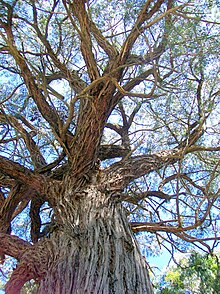
Trunk and bark of Eucalyptus agglomerata
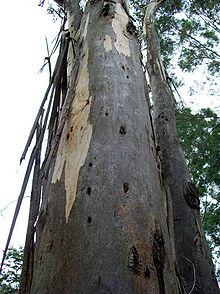
Trunk and bark of Eucalyptus amplifolia

Flower buds and flowers of Eucalyptus annulata

Funnel fruit eucalyptus ( Eucalyptus coccifera )

Silver dollar eucalyptus ( Eucalyptus cordata )

Eucalyptus deglupta as a neophyte in Hawaii
|
swell
literature
- John JW Coppen: Eucalyptus: The Genus Eucalyptus In: Medicinal and Aromatic Plants - Industrial Profiles , Volume 22, CRC Press, 2003. ISBN 978-0-2032-1943-0 . scanned.
Individual evidence
- ↑ a b c d ENCE : Sustainable Forest Management and Eucalyptus ( Memento of the original from February 22, 2015 in the Internet Archive ) Info: The archive link was automatically inserted and not yet checked. Please check the original and archive link according to the instructions and then remove this notice. (PDF), 2009, p. 10.
- ↑ Andrew D. Thomas, Rory PD Walsh, Richard A. Shakesby: Nutrient losses in eroded sediment after fire in eucalyptus and pine forests in the wet Mediterranean environment of northern Portugal. In: Catena , Vol. 36, No. 4, 1999, pp. 283-302.
- ↑ JCZ Woinarski, J. Risler, L. Kean: Response of vegetation and vertebrate fauna to 23 years of fire exclusion in a tropical Eucalyptus open forest, Northern Territory, Australia. In: Austral Ecology , Vol. 29, No. 2, 2004, pp. 156-176.
- ↑ Andrew Balmford: Wild hope - On the Front Lines of Conservation Success . The University of Chicago Press, London 2012, ISBN 978-0-226-03600-7 , pos. 1254.
- ↑ Stefan H. Doerr, Richard A. Shakesby, Rory PD Walsh: Spatial variability of soil hydrophobicity in fire-prone eucalyptus and pine forests, Portugal. In: Soil Science , Vol. 163, No. 4, 1998, pp. 313-324.
- ↑ HH Shugart, IR Noble: A computer model of succession and fire response of the high ‐ altitude Eucalyptus forest of the Brindabella Range, Australian Capital Territory. abstract In: Australian Journal of Ecology , Volume 6, No. 2, 1981, pp. 149-164.
- ↑ Forest fires in Portugal: The flames are still raging. In: Tagesschau. June 19, 2017. Retrieved June 20, 2017 .
- ↑ ENCE : Sustainable Forest management and Eucalyptus ( Memento of the original of February 22, 2015 in the Internet Archive ) Info: The archive link was automatically inserted and not yet checked. Please check the original and archive link according to the instructions and then remove this notice. (PDF), 2009, p. 7.
- ↑ Information on eucalyptus oil.
- ↑ Terry Porter: Recognize and use wood . Ed .: HolzWerken. 2nd Edition. Vincentz Network GmbH & Co KG, Hanover 2018, ISBN 978-3-86630-950-0 , p. 118 .
- ↑ Sert. Angl. , 1788, plate 20 scanned at biodiversitylibrary.org .
- ↑ LD Pryor, LAS Johnson: A classification of the eucalypts. Australian National University, Canberra, Australia, 1971.
- ^ Systematics according to Hill 1991: The Major Groups of Eucalypts - The Genera Eucalyptus, Corymbia and Angophora ( Memento from April 5, 2012 in the Internet Archive )
- ^ Murray Ian Hill Brooker : A new classification of the genus Eucalyptus L'Hér. (Myrtaceae) . In: Australian Systematic Botany . Volume 13, number 1, 2000, pp. 79-148, doi: 10.1071 / SB98008 .
- ↑ OC Parra, M. Bayly, F. Udovicic, P. Ladiges: ETS sequences support the monophyly of the eucalypt genus Corymbia (Myrtaceae). In: Taxon , Volume 55, 2006, pp. 653-663.
- ↑ a b Rafaël Govaerts (Ed.): Eucalyptus. In: World Checklist of Selected Plant Families (WCSP) - The Board of Trustees of the Royal Botanic Gardens, Kew . Retrieved October 2, 2017.
- ↑ Types accepted by EUCLID.
Web links
- The eucalyptus website on the Australian Native Plants Society website . (engl.)
- Description in the Western Australian Flora . (engl.)
- Link collection of the Center for Plant Biodiversity Research .
- Systematics at Euclid .
- Euclid - Website about the kinship group of the eucalyptus.
